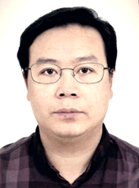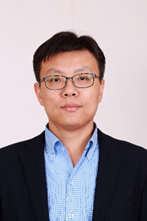

At the invitation of professor Jiao kui, vice director of the school of mechanical engineering, professor Ming Pingwen of TongJi University and Hou Zhongjun, vice general manager of ShangHai JieQing technology co.LTD., will come to give an academic report together. Your active participation is highly welcome.
Time for academic report: 23 May 2019(Thursday), 3:00PM
Report location:Hongyuan lecture hall, 37th building, school of mechanical engineering, Tianjin University.
About the speaker:

Ming Pingwen, professor and doctoral director of TongJi University, is a leading talent in scientific and technological innovation of "ten thousand plan". He used to work for DaLian Institute of Chemical Physics as the leader of battery general section,the director of research office and technology division,he also was the manager of UNDP fuel cell bus commercialization demonstration project leaded by the ministry of science and technology, and the director of national engineering research center of fuel cell and hydrogen source technology.
He mainly engaged in fuel cell reactor and system technology and process engineering research. As the main personnel, he undertook 973,863,and the Chinese academy of sciences and other major special fuel cell related topics more than 30, he first put forward the concept of supercharged vehicle fuel cell system and metal sheet electric reactor in China, taking the lead in fuel cell deep submersible sea trial and integrated reformer cogeneration experiment; And he organized the implementation of saic and other enterprises commissioned development projects, pushing forward the forward product and process development process, Based on its own technology, the company has developed for the first time in China a series of automotive electric reactors with a capacity of over 5000 hours and a service life. He has successively won the first prize and the second prize of science and technology of LiaoNing province twice, more than 60 papers published in international and domestic core academic journals, more than 90 patents authorized and effective invention and PCT invention of 2 pieces.
Report Topic:
Development status and thinking of hydrogen fuel cell
Abstract:
Commercialization of hydrogen fuel cell vehicles began in 2015. China encourages the development of new energy vehicles, including hydrogen fuel cell vehicles, under the constraints of energy and environment. Currently, fiscal subsidies for plug-in hybrid and pure electric vehicles will be withdrawn in 2020.Hydrogen fuel cell vehicles, on the other hand, will remain subsidized until 2020, and academics and industry have rolled out technology and commercialization roadmaps.
China's fuel cell vehicle technology preparation, started in 2000, experienced the 2008 Olympic Games, 2010 world expo technology demonstration demonstration. Since 2011, the company has entered the stage of product development under the guidance of automobile enterprises. Facing the global supply chain, the company is open to cooperation and has initially solved the problems of reliability (MTBF 1000hr), durability (5000hr) and low-temperature start-up (-20c).By the first quarter of 2018, China has delivered more than 1,000 fuel cell vehicles in total, with the largest single product delivery exceeding 300.
In the process of commercialization, some problems are gradually exposed.1) the production supervision and terminal refueling cost of hydrogen fuel is relatively high;2) high cost of hydrogen fuel cell system and weak industrial chain;3) fuel cell life and environmental adaptability need to be further improved.
The industry expects engineers and chemists to come up with better solutions, including: 1) how to get cheap fuel from cheap hydrogen plants for refuelling terminals, cheap and easy to use hydrogen storage materials innovation may still be the ultimate solution;2) in the fuel cell system equal to the power density of the current internal combustion engine, how can the core reactor move from 3kW/L to 9kW/L with the platinum consumption of no more than 10g per passenger car?3) the life requirement for internal combustion engine of commercial vehicles is 20,000 hours, how to improve from the current 5,000 hours。
China's scientific community, some progress has to solve these problems, such as: low platinum/non platinum catalyst, anti-corrosive coating, sheet metal stamping, based on the simulation of the heat capacity of ice crystal growth, start-stop control and the dynamic load attenuation control and so on, but still need to be in the catalytic layer and its slurry activity and flux increase, proton membrane strength and corrosion and swelling control, low cost manufacturing continuous improvement in many aspects, such as diffusion layer. Meanwhile, the storage and transportation of liquid hydrogen and/or supercritical hydrogen, large-scale light/water/wind/nuclear water electrolysis hydrogen production and gas pipeline transportation are being discussed in the industry. We look forward to international cooperation between the academia and the industry.
About the speaker:

Hou Zhongjun, a professor-level senior engineer, is the vice general manager of Shanghai JieQing technology co., LTD. He graduated from DaLian Institute of Chemical Physics in 2003. His research direction is proton exchange membrane fuel cell. He used to be the vice general manager and chief engineer of XinYuan power co.LTD. and national engineering research center of fuel cell and hydrogen energy technology.
He is engaged in the fuel cell power system, electric reactor and its key components of research and development, has the management or the main part of complete "863" and "973" project five research topic, research and development spending more than 160 million yuan, and obtain a series of scientific research, has published more than 30 papers, including more than 60 authorized invention patent and won the provincial science and technology reward the five. He is currently the vice chairman of the national technical committee on fuel cell standards of standardization administration of China.
He presided over the development of fuel cell battery modules and engine products, which were fully applied in the industrialization development of fuel cell vehicles in China, solved the durability problem of vehicle fuel cells, and realized the development and application of China's first high-power metal plate battery: HY – MOD of automotive fuel cell electric ® 300 type module is the first independent research and development of the durability of fuel cell products, beyond 5000 hours at the same time it can realize electric pile – 10 ℃ low temperature start, and 40 ℃ storage, successfully applied in automobile industry in our country the first fuel cell cars – Roewe 750 fuel cell cars and the fourth, our country's first commercial fuel cell multi-function car chase FCV80, fuel cell electric pile production more than 9000 kw, sales of more than 200 million yuan; Developed China's first meeting the application requirement of metal fuel cell electric reactor products HY – MOD ® 400, on the Roewe 950 fuel cell car small batch delivery applications. The fuel cell engine developed under the auspices of the Beijing Olympic Games in 2008, the Shanghai world expo in 2010 and the United Nations development program (UNDP) have been fully applied in the demonstration operation of fuel cell vehicles. The mass production process of fuel cell reactor is designed and developed.
Now he is the deputy general manager of Shanghai JieQing technology co.LTD., responsibling for enterprise development, and has developed a high power density double metal plate fuel cell electric products, reached the international first-class level, is in the leading position at home, at the same time based on the product development of high power fuel cell system has been realized in cars, buses and trucks and other vehicle platforms integration applications.
Report Topic:
Progress in vehicle proton exchange membrane fuel cell technology
Abstract:
Proton exchange membrane fuel cell technology application in automobile industry has entered the market promotion stage, the domestic and foreign research institutions and industry represented by car companies work together to solve the power density of the pile and key technical problems, such as life. Through technological progress and industrial application to reduce costs, and promote hydrogenation infrastructure construction, realize the commercial application of fuel cell vehicles. In China, the power density of proton exchange membrane fuel cell (PEMFC) has reached 3kW/L, which has solved the problem of service life. This report will introduce the research and development history of the corresponding work, discuss the development and application of fuel cell reactors and key technologies of the system, and analyze and look into the future technological development.